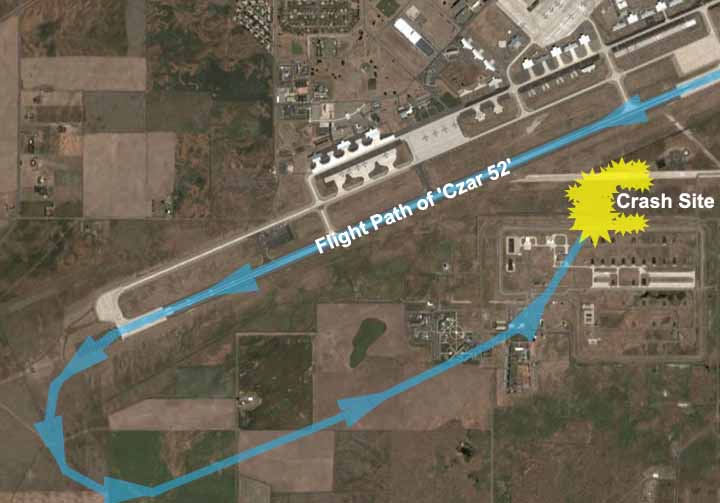According to NTSB data, there have been four fatal accidents of civilian-registered F-86 jets in the US. Two of them occurred during airshows and were caught on video. Below are those two videos, plus additional information from the NTSB investigation.
2 May 1993; El Toro Marine Corps Air Station, Santa Ana, CA:: A Canadair F-86E Mark 6,
N3842J crashed during a solo air show routine. The accident pilot had planned to participate in a mock dogfighting routine with a MiG-15. The pilot of the second airplane did not feel well and canceled his participation in the demonstration. The pilot of the accident aircraft then planned to perform a solo aerobatic routine, but it was one that the pilot had not practiced.
Ground personnel working with the pilot reported that as the airplane taxied out from parking, the pilot's shoulder harness was observed lying back behind the seat back and unsecured. While waiting for takeoff, the pilot made a radio request for assistance with the airplane's canopy from his ground crew. A witness reported observing the pilot leaning far forward in the seat of the airplane on the right side of the airplane. Shortly thereafter, the pilot canceled any assistance from his ground crew and took off from runway 34L.
After departure, the pilot performed a right 90 degree climbing turn, followed by a left 270 degree descending turn. This positioned the airplane over runway 16R at about 75 feet above ground level (AGL). The pilot then began a loop with an aileron roll at the top of the maneuver. Following the descent at the bottom portion of the loop maneuver, the airplane descended in a near nose and wing level attitude until striking runway 16R about mid-field. An intense explosion occurred. Wreckage was scattered along the runway for about a quarter mile. The pilot was killed, but no spectators were injured.
Required and actual altitudes and airspeedsThe aircraft operator reported that the loop maneuver in the accident airplane required a minimum of 275 knots at the entry point, and a minimum altitude of 4,000 feet above ground level (AGL) at 125 knots at the top of the maneuver. The operator indicated to FAA personnel that he observed the accident airplane's maneuver. He reported that it appeared to him that the accident airplane did not have the minimum entry speed. The operator estimated that the maximum altitude gained at the top of the maneuver was about 2,500 feet and the airplane appeared to experience an accelerated stall at 100 to 200 feet AGL just prior to impact. Additionally, the operator indicated that it was normal for the pilot to wear a "G" suit during his aerobatic routine, but at the accident site, the FAA found that the accident pilot was not wearing a "G" suit.
Pilot's military trainingThe aircraft operator reported that the pilot portrayed himself as an ex-naval aviator and A-4 pilot. U.S. Naval Investigative Service personnel assisted Safety Board investigators in an inquiry of the pilot's military experience. According to the NIS, the pilot was terminated from the U.S. Navy advanced jet training curriculum, Pensacola, Florida, on May 19, 1976.
NTSB Probable Cause DeterminationThe NTSB identified the probable causes as the pilot's inadequate planning decision making concerning performance of an aerobatic maneuver and his failure to maintain adequate altitude and clearance above the runway during recovery from the maneuver. Another related factor was the pilot's lower tolerance to “G”s by not wearing a “G” suit.
NTSB Factual ReportNTSB Probable Cause
1 June 1997; Broomfield, CO:: A Canadair F-86E Mark 6,
N3842J crashed during a solo air show routine. The pilot was performing a reverse half-Cuban eight. He flew down the runway at approximately 400 feet above ground level and pulled up using a 45-degree nose up attitude. At approximately 2,500 feet (AGL), the pilot rolled the aircraft inverted and pulled to a vertical nose down attitude. He failed to recover from the dive and the aircraft struck the ground in a 5-degree nose down attitude with a high sink rate. Ground speed at the time of impact was approximately 485 knots. The pilot was killed, and two airshow volunteers on the ground received minor injuries.
According to persons at the airshow who are aerobatics pilots, the maneuver being performed by this aircraft should be started no lower than 4,000 feet agl, and part of the altitude gain should be used to bleed off excess airspeed. Videos of the performance depict the speed brakes deployed, the vertical stabilizer moving up and down, and the leading edge devices deployed while the aircraft was in the dive.
Pilot experienceThe accident pilot had 14 years of experience as a military pilot, including experience as a fighter pilot, and 24 years as an airline pilot. He held an airline transport pilot and was type rated in several airliner models. In addition, the pilot held a flight engineer certificate in turbo jet powered aircraft. A National Transportation Safety Board air safety investigator witnessed the pilot's show performance the previous day.
Link to video of this crashProbable causeThe National Transportation Safety Board determined that the probable cause of this accident was inadequate planning and decision making by the pilot in starting the aerobatic maneuver at an insufficient altitude to successfully complete the maneuver.
NTSB Factual InformationNTSB Probable Cause



















